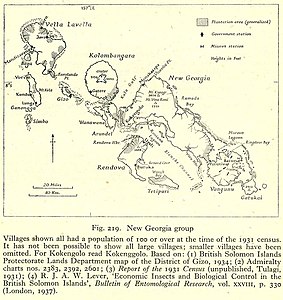Tetepare
| Tetepare | ||
|---|---|---|
| Tetepare satellite image | ||
| Waters | Solomon Lake | |
| Archipelago | New Georgia Archipelago | |
| Geographical location | 8 ° 45 ′ S , 157 ° 33 ′ E | |
|
|
||
| length | 27 km | |
| width | 8 kilometers | |
| surface | 118 km² | |
| Highest elevation | 357 m | |
| Residents | uninhabited | |
| Map of the New Georgia Archipelago | ||
Tetepare is an uninhabited island in the western province of the Solomon Islands . It belongs to the southern islands of the New Georgia Archipelago and has an area of approximately 118 km². Tetepare is 2,600 meters east of the southern tip of Rendova , the closest island to which it is separated by the Balfour Channel . The rugged island, up to 27 km long and 8 km wide, is on average 200 meters above sea level. The highest point on the island is 357 meters high. Tetepare is characterized by a unique ecology, is home to one of the leading nature conservation projects in the Solomon Islands and is locally owned and managed. The island is considered to be the largest uninhabited tropical island in the South Pacific .
history
The origin and meaning of the name Tetepare has not been clarified beyond doubt. However, it is believed that the name probably means "wild pig" or "fighting boar".
Until the mid- 19th century , Tetepare was inhabited by people who lived and farmed in larger communities on the island. From 1860 the island was completely abandoned due to illness and fear of armed conflict and has been uninhabited since then. The original residents emigrated to the neighboring islands of New Georgia , Vonavona , Nggatokae and Ranongga .
ecology
Almost the entire inner island area is covered with untouched lowland rainforest . The areas near the coast offer three species of turtles the opportunity to lay their eggs. At the western tip of the island, a 3.75 square kilometer coconut plantation , the Tetepare Plantation, was created in the years 1907–1918. However , its operation has declined since the Second World War and was completely discontinued from 1990 onwards. The secondary forest has since regained the former plantation area. Tetepare is the only island in the Solomon Islands whose forests have not been destroyed by commercial deforestation and are still untouched. At the beginning of this century, with the threat of logging over Tetepare, the island's traditional landowners turned down the logging offer and came together to preserve this pristine wilderness for themselves and future generations. An organization made up of members of the local community called the Tetepare Descendants' Association (TDA) was formed to manage and protect the island's resources as a protected area . Tetepare has received international recognition for its conservation and ecological importance. Experts from around the world, including the renowned evolutionary biologist and author Jared Diamond , praised the work on the island.
literature
- Dr. John L. Read: The Last Wild Island: Saving Tetepare Page Digital Publishing Group, Adelaide (South Australia) 2011, ISBN 978-0-9807600-3-3
Web links
- Website of the Tetepare Descendants' Association (TDA) (English)
- Report of the United Nations (UNDP) development program on the work of TDA (English)
Individual evidence
- ^ Vertebrates of Tetepare Island, Solomon Islands. (PDF) Read / Moseby, January 2006, p. 1 , accessed on December 27, 2017 (English).
- ↑ a b c d The great exodus of Tetepare islanders ( Memento of November 7, 2007 in the Internet Archive ) (pdf, English).
- ↑ About Tetepare Island. Tetepare Descendants' Association, 2012, accessed December 27, 2017 .


